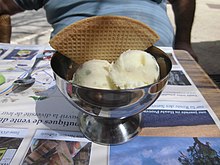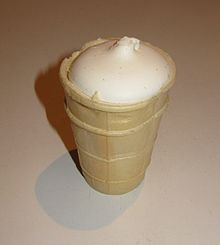Plombières (dessert)

Plombières is a type of French ice cream made with almond extract, kirsch, and candied fruit.[1]
History


The origin of plombières ice cream is disputed.[2] It is unclear whether its name refers to the commune of Plombières-les-Bains. A folk etymology suggests that the dish was first served to Napoleon III at the signing of the Treaty of Plombières[1] in 1858; but Marie-Antoine Carême provided a recipe for "plombière cream" in his 1815 book, Pâtissier royal parisien.[3] Similar recipes can be found in other French cookbooks from the 19th century.[4][5]
According to Pierre Lacam in 1893, "plombière cream" takes its name from a utensil used to make it.[6] A similar etymological theory was proposed by Joseph Favre in his book Dictionnaire universel de cuisine, which says that "plombière is a synonym for bombe, which is used to grind the ingredients of the dish".[7] Other scholars have suggested that the dessert takes its name from the mold in which the cream is pressed.[8]
Plombières ice cream is mentioned in Splendeurs et misères des courtisanes, published in 1844 by Honoré de Balzac.[9]
Plombières should not be confused with Malaga ice cream, a vanilla ice cream served with dried raisins soaked in Malaga wine or rum.[10]
In the Soviet Union, plombir (Russian: пломбир) became a popular dish that is still seen in post-Soviet states.
See also
References
- ^ a b Anders (13 September 2012). "Glace Plombières – A French classic". ICE CREAM NATION. Retrieved 2019-11-19.
- ^ « La glace Plombières : références littéraires », www.glace-plombieres.fr (consulté le 6 février 2019).
- ^ Le Pâtissier royal parisien ou Traité élémentaire et pratique de la pâtisserie ancienne et moderne, Paris, J.-G. Dentu, 1815, tome II, p. 142, sur Gallica.
- ^ Antonin Carême, Le Maître d'hôtel français, Paris, 1822, (sur Gallica).
- ^ Le Gastronome, Paris, 1830, p. 7, sur Gallica.
- ^ Pierre Lacam, Le Glacier classique et artistique en France et en Italie, Paris, 1893, p. 3, sur Gallica.
- ^ J. Favre, Dictionnaire universel de cuisine, Paris, tome IV, 1905, p. 1591, sur Gallica.
- ^ Quinzio, Geraldine M. Of Sugar and Snow: A History of Ice Cream Making. University of California Press. p. 69.
- ^ Honoré de Balzac, Splendeurs et misères des courtisanes, dans la partie
, Œuvres complètes de M. de Balzac, t. XI, édition Furne, J.-J. Dubochet et Cie, J. Hetzel et Paulin,1844, p. 568.À combien l'amour revient aux vieillards
- ^ Malissin, Pierre-Emmanuel (2015-05-30). Glaces et Sorbets (in French). Syllabaire Éditions. ISBN 9782365042826. Retrieved 2018-11-21..
